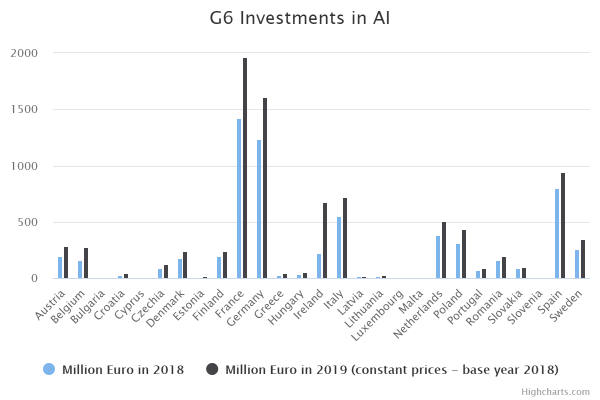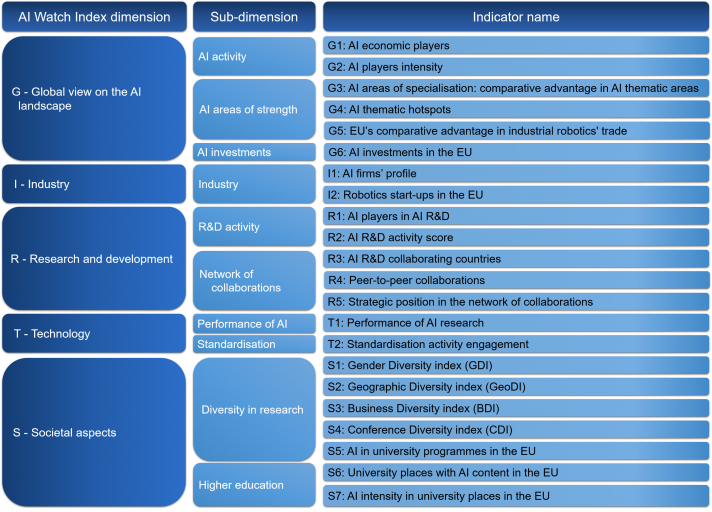The AI Watch Index provides a structured set of quantitative indicators on the performance and positioning of the EU across various dimensions of AI relevant for policymaking.
The index is organised around five dimensions:
- G: Global view on the AI landscape,
- I: Industry,
- R: Research & development (R&D),
- T: Technology,
- S: Societal aspects.
The diagram below presents an overview of the 22 indicators organised around these 5 dimensions.

This dimension of the AI index provides the basis for understanding the global landscape of AI and covers general aspects of its composition and geographical distribution, areas of AI specialisation, and AI investments in the EU.
The G1 indicator measures the number of the three types of economic players included in the AI landscape analysis:research institutes, firms and governmental institutions.
The G2 indicator expresses the presence of AI economic players in relation to the size of the economy.
AI areas of specialisation: comparative advantage in AI thematic areas
AI thematic hotspots
Comparative advantage in robotics' trade for the EU27

AI investments

Presents AI firms’ profiles and also includes a focus on robotics start-ups, in order to understand the characteristics of the AI industry.
AI firms’ profiles indicator characterises the AI industry in a geographical area by means of the distribution of AI firms according to their business type
The number of new robotics businesses founded each year

Elaborates on the EU’s capabilities and strengths in research, covering various aspects of R&D activity (e.g., patenting, publications and EU funded projects) and network of collaborations.
The R1 – AI players in AI R&D indicator shows the presence of players active in AI R&D activities, to assess how distinct geographical areas are involved in the technical development of AI.
This indicator assesses the level of involvement of different geographical areas in AI R&D activities, by considering the weight of the activities developed by AI economic players and therefore taking into account the relative importance of players.
With this indicator we investigate the EU 27 Member States’ propensity to structure collaborations with many different countries.
This indicator measures how many collaborations are developed by AI players from each geographical area (or Member State) by type of R&D activity: patent applications, frontier research publications and, when analysing the EU, EC-funded projects.
This indicator provides a metric for players’ capacity to act as connecting bridges between other players, aggregated at the geographical level, to assess the influence that a geographical area can exert on other areas thanks to the structure of collaborations in which they are involved.

Analyses AI as a general purpose technology, in aspects such as technological enablers, performance of AI and standardisation.
This indicator addresses evaluation of technical progress in an illustrative set of AI tasks belonging to different sub-areas using a combination of quantitative measurements, such as in popular AI benchmarks and prize challenges.
This indicator provides an overview of the AI standardisation landscape across multiple international and European standards development organisations (SDOs).

Covers two sub-dimensions: diversity in research, including gender diversity, and higher education offer in AI.
The Societal Aspects dimension includes four indicators addressing Diversity in Research. They measure different aspects related to diversity among participants (i.e., keynote speakers, conference organisers and authors of papers) at a set of international AI conferences.
This indicator evaluates the intensity with which AI is considered in official curricula, as a proxy of AI skills acquired by current students (and therefore, future workers).
This indicator measures the number of available places in university programmes with AI content for each Member State.
This indicator measures the proportion of available places in university programmes with AI content in total number of places in university programmes by Member State.

